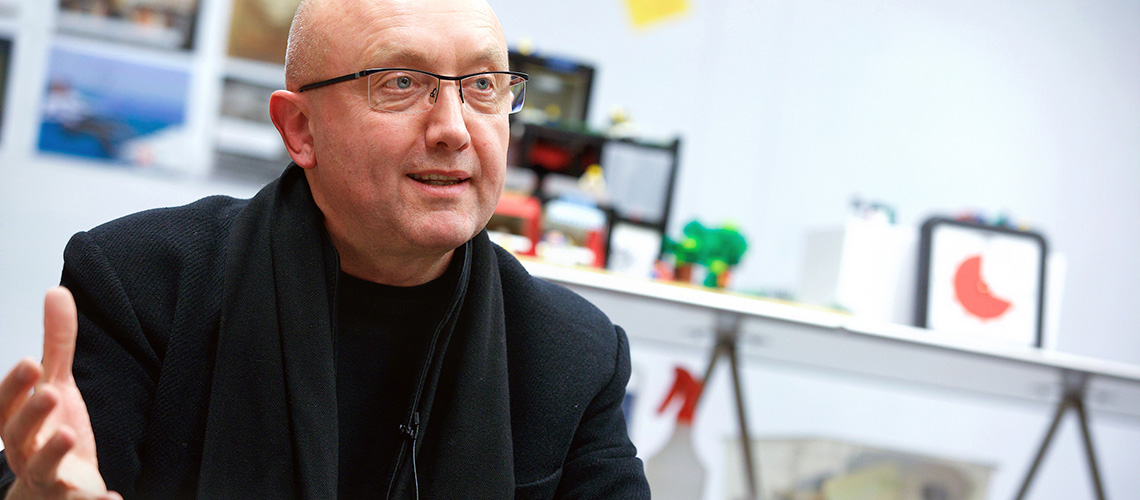The way we work on a day-to-day basis is changing. As businesses develop and technologies advance, collaborative working has become a key focus. Professor Ulrich Weinberg, director of the School of Design Thinking at the Hasso-Plattner-Institute, has spearheaded this shift, placing more value on group contribution, rather than individual competition, in professional environments and beyond. The professor has given Staples Business Advantage insight into what collaborative working is and why it’s so important.
The end of Brockhaus Thinking

In a Ted X Talk given by Professor Weinberg, he explained the concept of “Brockhaus Thinking”. He’s developed this model as a metaphor for the linear ways of thinking which are prevalent in the majority of organisations today.
“Brockhaus” refers to a famous encyclopaedia which was commonplace in Germany for 200 years, but discontinued in 2014. The publishers missed the opportunity to digitalise the books, so they were never transitioned into the modern mediums so many readers rely on today. Weinberg uses these encyclopaedias to illustrate a linear thinking model – the information is presented in a logical way, with progression from A-Z. The books only contain a finite amount of information. Their failure to move with the times has led to them becoming obsolete.
He explains “[this] is the easiest way I’ve found so far to describe the paradigm shift from the old way of analogue, linear, disconnected thinking to a digital new way of connected, Network Thinking”.
Weinberg admits though the idea of this progression sounds simple, there’s a lot to contend with as “we are living in a world which is defined by those kinds of [linear] structures”.
The structures which frame our default “linear thinking” are presented to us at an early age through school systems, the professor theorises. This is where we’re first taught to compete rather than cooperate. “We are not prepared for a collaborative environment” Weinberg argues, “we are all prepared for a highly competitive environment”.
Importance is placed on “individual competition” in many work places and this is evident even in our youngest years. Weinberg believes schools are where we see the “defining moments of Brockhaus Thinking”. He muses that there’s an emphasis on looking at things too singularly.
“It’s not about the combination […] it’s more about this individual measurement which we train for at school. With first grade, kids learn that their classmates are their competitors – they have to be better than the other kids. All kids learn the same pattern – and it’s not the pattern of collaboration, it’s the pattern of competition.”
It’s at this point we begin to fall into the pattern of Brockhaus Thinking which can be difficult to circumnavigate in later life. As the professor explains “the problem is, in the real world, in the networked world we are living in now, that kind of pattern is obsolete”.
It would seem that the boundaries of Brockhaus Thinking have to be broken down in order for companies to innovate and move forwards. Teamwork is an essential component of this process, and something more and more organisations are looking to implement. In the professor’s opinion, companies would have it much easier if students left academia with knowledge of “networking, of bringing people together”. The future of business success lies with the collective – which is why Network Thinking would seem to be the necessary next step.
Collaborative working and Network Thinking

The growing complexities of the world we live in demands us to think outside the box. An individual embarking on a single path to solve a problem, it could be argued, is not as efficient or productive as a group collectively discovering several paths and solutions. This is exactly the premise of Network Thinking. Weinberg believes in order to allow people to be more creative and arrive at new solutions to complex problems, we need to be moving towards more inclusive, less individual processes.
The Network Thinking model developed by the professor has three key areas of focus:
Network Thinking is about encouraging people to work with their colleagues instead of alongside them. This combined approach, when properly supported and facilitated, can be very successful for an organisation. Network Thinking focuses on how important it is to break away from traditional, linear methodologies and embrace modern methods which embrace wider participation and encourage collaboration.
The three steps towards achieving network thinking can be implemented in any business. With project work, ideation or problem solving, be sure to include a range of people from a mix of different disciplines. This can help to gain broader insight into the project at hand, and result in a plethora of unique solutions or ideas. Encourage these teams not to think that the problem solving or ideas process has to be in a logical A-Z format. Giving them the freedom to reiterate different stages will help to gather a wealth of information that they can then distil into core ideas at a later point. Finally, make sure the environments they are working in are equipped to help this group-thinking process. Tables that allow close working in small groups, flip charts, whiteboards and Post-it® Notes are all examples of the kinds of things that can help people working with a multitude of ideas.
The changes organisations are making to adapt to the demands of the modern world extends even further than processes. In some cases it’s the organisational structures themselves which are changing to accommodate a more inclusive way of working. The notion of hierarchy is something Weinberg believes needs to radically move with the times.
“What kind of leadership models are appropriate in a world where connectivity, exchange, openness and collaboration are key, not competition? Self-organising teams don’t need a big hierarchical structure above them because they can do lots of things on their own. […] We are using the kind of structures which actually keep us away from really good solutions to complex problems. We just try to solve complex problems right now, but we don’t use the full mental capacities of our people […] we have to allow them and enable them to use their capacities in a new way. ”
On a recent trip to China to visit the CEO of Haier, one of the largest electrical appliance companies in the world, the professor was given a glimpse into the kinds of collaborative structures companies could be adopting in future. Having read Professor Weinberg’s book about Network Thinking, the CEO began implementing big changes:
“He has 70,000 people and is rearranging the whole company structure towards an ecosystem of microenterprise. He enables people to be entrepreneurs in the structure of their company and I am completely with him that this is probably the best structure of large organisations […] I’m talking about radical changes, radical approaches which are, from my perspective, urgently necessary”.
The importance of collaborative working spaces

The physical design of a working environment can go a long way to facilitating productive and innovative thinking. The traditional office space as we know it needs to change to accommodate new collaborative methods of working.
Weinberg extols the virtues of variable workspaces. He explains the ways in which he has redefined the parameters of working spaces for his own collaborative needs. The development of “We Q” spaces has been key to shifting the focus from spaces that support the individual, to spaces that support group thinking.
“At the School of Design Thinking, we designed ‘We Q’ spaces, which are actually not ‘IQ’ representing the intelligence of a single person in the ‘I’ model – it’s more the ‘we’ qualities and we focus on that. We had to physically redesign the spaces […] working environments need to be redesigned and we are encouraging companies to do that”.
The professor found for his own team-working needs, there was a serious lack of equipment available. There were no pieces of furniture to accommodate groups of four or five people working collaboratively, and the spaces were unequipped to help with the group ideas process. He went as far as designing his own pieces to meet the requirements for smaller “collaboration tables” which accommodated small groups working together. Within the Network Thinking model, the physical environment is a significant part of what helps the process to work. The environment must facilitate the dynamic thinking process.
Why collaboration is important

The benefits of collaborative working are significant. It boosts productivity, efficiency and encourages team-work and communication. Take away the “competitive” element which is ingrained in so many of us when working individually and you may find a group effort can yield great results. With the world today being a place where connection is such an important part of everything we do – especially with evolving technology and social media - it makes sense that this would start to have an effect on the ways we work and interact. By following the three steps outlined in the Network Thinking model, organisations can begin to see a real positive change in day-to-day working processes, and the output. From varying the people who work in groups, to allowing the freedom of an iterative process, and facilitating collaboration with physical equipment and varying work spaces – these are simple ideas to implicate, but they can have a big impact on the ways the company as a whole works.
With Network Thinking, it’s a joint effort – from the company who facilitates this way of working to those who are a part of the group undertaking the work. As Professor Weinberg puts it,
“We are encouraging people to join forces, building bridges between different departments and building cross-functional, small teams which can operate faster than big departments […] this offers new chances and lots of new opportunities”.
You can call a Staples representative at the following number:
+44 (0) 121 322 1000
You can also fill out the form below and one of our representatives will get in touch with you shortly.